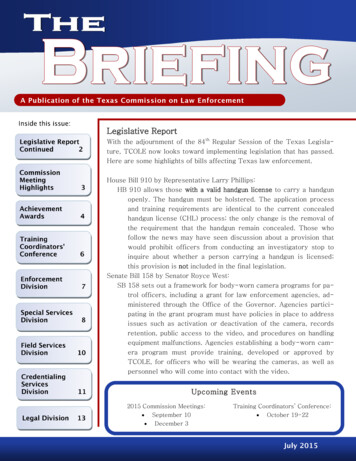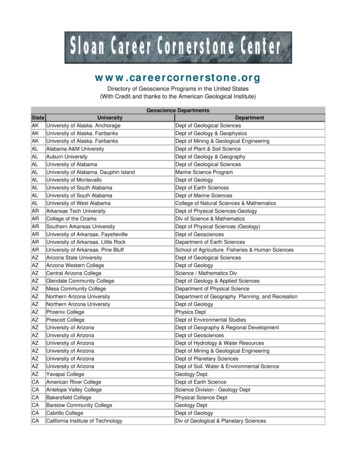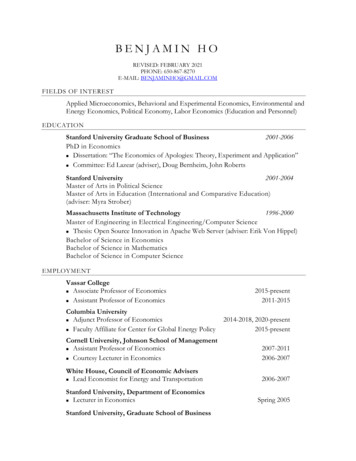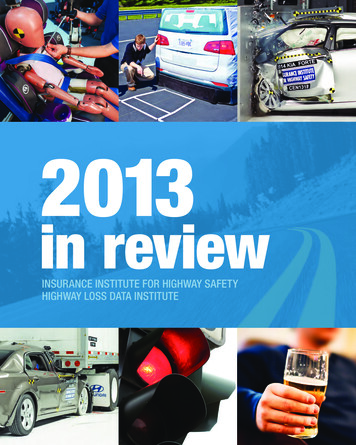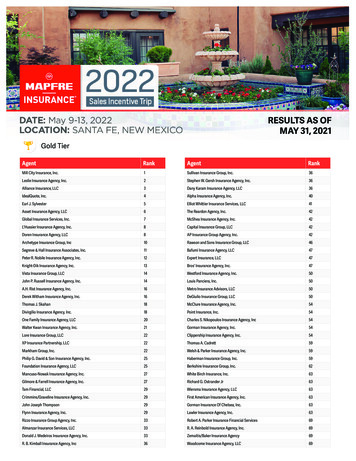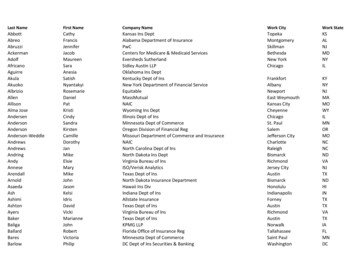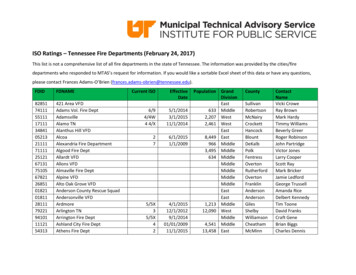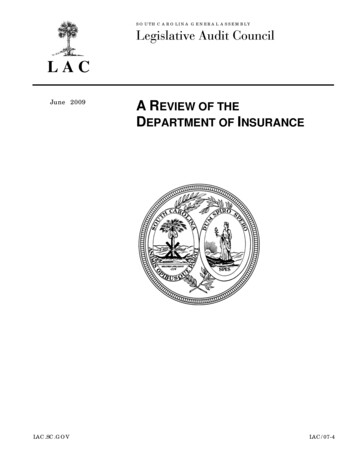
Transcription
SOUTH CAROLINA GENERAL ASSEMBLYLACJune 2009LAC.SC.GOVA REVIEW OF THEDEPARTMENT OF INSURANCELAC/07-4
LEGISLATIVE AUDIT COUNCIL1331 Elmwood Ave., Suite 315Columbia, SC 29201(803) 253-7612 VOICE(803) 253-7639 FAXPublic MembersPhilip F. Laughridge, CPA, ChairmanThomas F. HartnettS. Jahue (Jake) Moore, Esq.C. Dorn Smith, III, M.D.Members Who Serve Ex OfficioRaymond E. Cleary, IIISenate Judiciary CommitteeMichael L. FairSenate Finance CommitteeRex F. RiceHouse Ways & Means CommitteeWalton J. McLeodHouse Judiciary CommitteeDirectorThomas J. Bardin, Jr.Authorized by §2-15-10 et seq. of the South Carolina Code of Laws, theLegislative Audit Council, created in 1975, reviews the operations of stateagencies, investigates fiscal matters as required, and provides information toassist the General Assembly. Some audits are conducted at the request ofgroups of legislators who have questions about potential problems in stateagencies or programs; other audits are performed as a result of statutorymandate.The Legislative Audit Council is composed of five public members, one ofwhom must be a practicing certified or licensed public accountant and one ofwhom must be an attorney. In addition, four members of the GeneralAssembly serve ex officio.Audits by the Legislative Audit Council are conducted in accordance withgenerally accepted government auditing standards as set forth by theComptroller General of the United States.Copies of all LAC audits are available at no charge. We encourage you tovisit our website to view and print copies of LAC reports.LAC.SC.GOVA Review of the Department of Insurance was conducted by the following audit team.Audit ManagerAndrea Derrick TruittTypographyCandice H. PouMaribeth R. WertsLAC.SC.GOVAuditorsKristina A. CarefelleBeverly T. Riley, CPAKatie E. WoodlieffLegal CounselAndrea Derrick TruittLAC/07-4
SOUTH CAROLINA GENERAL ASSEMBLYA REVIEW OF THEDEPARTMENT OF INSURANCELAC.SC.GOVLAC/07-4
Page iiLAC/07-4 Department of Insurance
ContentsSynopsis. vChapter 1Introductionand BackgroundAudit Objectives . . . . . . . . . . . . . . . . . . . . . . . . . . . . . . . . . . . . . . . . . . . . . 1Scope and Methodology . . . . . . . . . . . . . . . . . . . . . . . . . . . . . . . . . . . . . . . 1Background. 2Chapter 2Audit ResultsWorkers’ Compensation Insurance . . . . . . . . . . . . . . . . . . . . . . . . . . . . . . . 7Coastal Property Insurance . . . . . . . . . . . . . . . . . . . . . . . . . . . . . . . . . . . . 13Overall Regulation of Insurance . . . . . . . . . . . . . . . . . . . . . . . . . . . . . . . . 18Captive Insurance . . . . . . . . . . . . . . . . . . . . . . . . . . . . . . . . . . . . . . . . . . . . 28AppendixAgency Comments . . . . . . . . . . . . . . . . . . . . . . . . . . . . . . . . . . . . . . . . . . . 33Page iiiLAC/07-4 Department of Insurance
ContentsPage ivLAC/07-4 Department of Insurance
SynopsisMembers of the General Assembly requested the Legislative Audit Council toconduct an audit of the South Carolina Department of Insurance (DOI). Ouraudit focused on four main areas: Workers’ Compensation InsuranceCoastal Property InsuranceOverall Regulation of InsuranceCaptive InsuranceWhile we found that DOI generally regulates the insurance industryappropriately, we found many areas where improvement is needed to ensurethat the department, the insurance industry, and the public are aware ofpossible problems and issues. Our findings are summarized below.Workers’CompensationInsuranceWe reviewed how DOI regulates workers’ compensation insurance byexamining rate filings and overall industry data. We also looked at how otherstates regulate workers’ compensation insurance to recommend possiblechanges in state law. Overall, 73 (97%) of 75 of the rate filings reviewed had missinginformation. This information included financial data, actuarial reviews,and approvals. Forty-one filings (55%) were exempt from prior approvalbased on the deregulation in South Carolina law between 2003 and 2007.Without a summary document or checklist in each filing, as well as theappropriate information from insurers, it is difficult to determine if theappropriate analysis or any analysis was conducted by the department.Insurance companies are allowed to use any year’s loss cost data whencalculating rates. In order to prevent the possibility of companies’manipulating rates and to be consistent with other states, state law shouldbe amended to require insurers to use the most recently approved losscost data when calculating rates.Page vLAC/07-4 Department of Insurance
SynopsisCoastal PropertyInsuranceWe reviewed how DOI regulates coastal property insurance and if thatregulation is in compliance with state law and insurance industry standards.We also reviewed how the South Carolina Wind and Hail UnderwritingAssociation (SCWHUA) operates. The regulation of coastal propertyinsurance was also examined to determine if any changes could be made toimprove the regulation in South Carolina. Overall Regulationof InsuranceNine (25%) of 36 filings reviewed had no evidence of DOI’s review or anexplanation of its decision. Completing checklists that DOI already hasand including them in the file would show that the department isevaluating all aspects of the filings and how it reached its decision.As required by state law, SCWHUA should include procedures in its planof operation for procurement of reinsurance. These procedures shouldinclude better use of evaluation criteria to make the process more openand objective.The department should continue its efforts to evaluate hurricane modelsfor South Carolina to ensure that the rates charged by insurers areappropriate.We reviewed how the department regulated other types of insurance such aslife, health, and automobile insurance. We looked at how DOI ensures thefinancial solvency of insurance companies and reviews rate increase requests. We reviewed rate change requests submitted to DOI to determine whetheradequate procedures were in place for analyzing the requests in order tomake appropriate decisions for approval or denial. We generally foundadequate support for the decisions. By failing to document all aspects of arate change request, the department’s decisions may not be adequatelyexplained or supported.We reviewed the operations of the financial analysis division todetermine if the department ensures that insurance companies complywith South Carolina law and National Association of InsuranceCommissioners’ (NAIC) guidelines. We found that the files containedadequate documentation to establish that desk audits had been conductedin accordance with South Carolina laws and NAIC regulations. However,none of the samples indicated that the risk-based capital ratio had beenreconciled between the company’s annual statement and the NAICcalculations.Our examinations of the DOI schedule of audits confirmed thatexaminations were scheduled and completed in accordance with statelaw.Page viLAC/07-4 Department of Insurance
SynopsisCaptive InsuranceWe reviewed DOI’s regulation of captive insurance companies which are arisk-financing method or form of self-insurance involving the formation ofcompanies to serve the insurance needs of parent companies or theirmembers. We found that generally the department’s licensing andexaminations of captives complies with state law and regulations. We didfind the following problems with DOI’s regulation of captives. We found that the department did not collect all of the requiredinformation from companies. Without this information, the departmentmay not be able to adequately determine if the company will be able toremain financially solvent and protect its parent company or members.The department did not have standard procedures for conducting thefinancial examinations of captives which are not risk retention groups.These examinations are required by state law. The agency has nowdeveloped standard procedures and, according to an agency official,implemented them in December 2008.We reviewed DOI’s schedule of examination dates for captives and foundthat 43 (81%) of 53 reviews had not been completed within the three-yearperiod required by state law. By not having procedures as discussedabove and failing to complete examinations as required by law, thedepartment cannot adequately ensure that the captive insurancecompanies are able to meet their financial obligations.Page viiLAC/07-4 Department of Insurance
SynopsisPage viiiLAC/07-4 Department of Insurance
Chapter 1Introduction and BackgroundAudit ObjectivesMembers of the General Assembly requested the Legislative Audit Councilto conduct an audit of the South Carolina Department of Insurance (DOI).The requesters had four main areas of concern: Workers’ compensation insurance rates.Coastal property insurance rates and availability.Overall regulation of insurance.Captive insurance.Our objectives were to determine how the department regulates workers’compensation insurance, coastal property insurance, and the insuranceindustry, and if that regulation is in compliance with the law and insuranceindustry standards. As part of the coastal property insurance review, we alsoexamined the operations of the South Carolina Wind and Hail UnderwritingAssociation (SCWHUA).Scope andMethodologyWe reviewed the operations of the department including its rate approvalprocess and the licensing and examination of insurance companies. We didnot review how DOI licenses insurance agents, handles complaintsconcerning insurance companies and agents, or administers its operations.We also reviewed the operations of SCWHUA. The period of review wasgenerally FY 05-06 and FY 06-07, with consideration of earlier and morerecent periods when relevant.To conduct the audit, we used evidence which included the following: DOI records of licensing, rate requests, financial analyses, andexaminations.Federal and state laws and regulations.Interviews with DOI employees, employees of other states’ insurancedepartments, and other interested parties.DOI financial records, policies, and bulletins.Information and accreditation reviews from the National Association ofInsurance Commissioners (NAIC).Records from the S.C. Wind and Hail Underwriting Association.Page 1LAC/07-4 Department of Insurance
Chapter 1Introduction and BackgroundCriteria used to measure performance included state laws and regulations,agency policy, the practice of other states, and insurance industry standards.We used several nonstatistical samples, the results of which cannot beapplied to the whole population. These samples are described in the auditreport. We reviewed internal controls in several areas including licensing,ratemaking, and financial analyses and examinations. Our findings aredetailed in the report.When addressing our audit objectives, we used information from several ofDOI’s information systems. We could not audit or verify all of theinformation obtained from these systems, and we concluded that it may beunreliable. However, we analyzed the information we received and comparedit with other sources and known evidence. We concluded that the evidenceobtained was adequate to support the findings, conclusions, andrecommendations in the report. We conducted this audit in accordance withgenerally accepted government auditing standards.BackgroundThe South Carolina Department of Insurance (DOI) is a state agency which ismanaged by a director who is appointed by the Governor with the advice andconsent of the Senate. The director is responsible for supervising andregulating the financial solvency and market practices of insurers in SouthCarolina and ensuring that all state laws governing or relating to the businessof insurance are executed.The mission of the department is to be responsible for ensuring the solvencyof insurers, protecting consumers by administering and enforcing insurancelaws, and regulating the insurance industry in an efficient, responsive, andequitable manner.Page 2LAC/07-4 Department of Insurance
Chapter 1Introduction and BackgroundThe department is divided into four strategic areas.GENERAL COUNSEL AND FINANCIAL SERVICES DIVISION oversees all legalservices, insurer licensing, and financial solvency matters.DIVISION OF CONSUMER SERVICES AND AGENTS LICENSING is primarilyfocused on education and licensing of insurance producers, brokers,service contract providers, third-party administrators, bail bondsmen,utilization review agents, premium service companies, and insurancerelated organizations’ affiliates as required by law. The division alsohandles consumer complaints.DIVISION OF ADMINISTRATION AND GRANTS SERVICES directs humanresources for approximately 100 full-time employees and manages theagency’s central file records. The division also provides publicinformation and administers mitigation grants to strengthen homesagainst the severe winds associated with hurricanes and natural disasters.DIVISION OF ACTUARIAL, MARKET AND ALTERNATIVE RISK TRANSFERSERVICES handles the rates, rules, and forms submitted by insurancecompanies and analyzes their market conduct. The division manages thecaptive insurance industry and other alternative risk transfer mechanismsin the state and provides, manages, and outsources actuarial duties thatare required by the department.DOI regulates all types of insurance sold in South Carolina, such as lifeinsurance and annuities, accident and health, property, casualty, surety,marine, and title unless exempted from regulation by state law. Insurancecompanies are required to pay license fees and annual premium taxes.License fees are also required for insurance producers and brokers, bailbondsmen, adjusters, damage appraisers, administrators of insurance benefitplans, service contract providers, and reinsurance intermediary brokers.The department collects approximately 175 million each year in taxes andfees from the insurance industry. As required by statute, more than 95% ofthat revenue is transferred to the general fund. Less than 5% is earmarked orrestricted for DOI use. The General Assembly then appropriates funding forthe agency, which amounts to less than 7% of the revenue that was collected(see p. 4). Table 1.1 shows revenues collected and expenditures forFY 05-06, FY 06-07, and FY 07-08.Page 3LAC/07-4 Department of Insurance
Chapter 1Introduction and BackgroundTable 1.1: South CarolinaDepartment of InsuranceRevenues and ExpendituresFY 06-07(% OF TOTAL)FY 05-06(% OF TOTAL)FY 07-08(% OF TOTAL)REVENUES*Transferred toGeneral FundEarmarkedRestrictedTOTAL 147,151,799 (97%) 177,121,742 (95%) 168,903,074 (96%)2,920,9131,883,757 151,956,4697,535,2701,817,663 186,474,6755,217,1951,750,251 eneral Fund 3,599,909 (41%) 4,287,999 (43%) 5,329,893 (40%)Earmarked3,408,224 (39%)1,750,936 (20%) 8,759,0693,922,841 (39%)1,838,983 (18%) 10,049,8236,191,561 (47%)1,708,038 (13%) 13,229,492RestrictedTOTAL*Examples of general revenues collected include broker premium taxes, workers’ compinsurance tax, insurance premium tax, insurance license fees, and others. Examples ofearmarked funds collected are examining fees and travel reimbursement, agent licensefees, captive insurance company fees and assessments, and other miscellaneous revenue.Examples of restricted funds collected are uninsured motorist fund administration ofinvestment earnings and miscellaneous transfers.** Examples of general and earmarked expenditures include staffing and benefits, utilities,data processing equipment, and general operating expenses. Examples of restrictedexpenditures include office and postage supplies and expenses allocated to the privatesector.Source: DOI and Office of Comptroller GeneralThe department is regulated by state law and is a member of the NationalAssociation of Insurance Commissioners (NAIC). The NAIC is anorganization of insurance regulators from the 50 states, the District ofColumbia, and 4 U.S. territories that provides a forum for the development ofuniform policy among insurance departments. The NAIC also functions as arepository for insurance data for the states. Similar information is assembledfrom all insurance companies and is made available to all state departmentsof insurance. The financial data assembled by the NAIC is used by statedepartments of insurance in the analysis of insurer financial statements andexaminations.Page 4LAC/07-4 Department of Insurance
Chapter 1Introduction and BackgroundNAIC accreditation reviews are conducted every five years, with morefrequent interim reviews. Each year, the department submits an interim reportconcerning its compliance with NAIC accreditation standards. According tothe DOI Agency Accountability Report for Fiscal Year 2006-2007,accreditation indicates to other insurance departments, existing and potentiallicensees, and other department stakeholders that DOI maintains qualifiedstaff, has appropriate insurance company solvency monitoring safeguards inplace, conducts financial examinations and financial analysis in compliancewith NAIC’s guidelines, and has enacted the necessary statutes andregulations to adequately govern South Carolina’s insurance industry.The department successfully completed its five-year accreditation review byNAIC in 2006. Its next accreditation visit is scheduled for Spring 2011.Page 5LAC/07-4 Department of Insurance
Chapter 1Introduction and BackgroundPage 6LAC/07-4 Department of Insurance
Chapter 2Audit ResultsWorkers’CompensationInsuranceWe reviewed how the South Carolina Department of Insurance (DOI)regulates workers’ compensation insurance by examining rate filings andoverall industry data. We found that 97% of the rate filings reviewed hadmissing information including financial data, actuarial review, and approvaldetails. However, the department reports that 41 (55%) of these filings werebetween June 2003 and June 2007 and thus, exempt from filing submissionand prior approval. We also found that state law does not require insurancecompanies to use the most recently approved loss cost data when calculatingrates.Workers’ compensation insurance is required by state law for mostemployers and provides benefits if an employee suffers job-related injury,disease, or death, regardless of fault. The S.C. Workers’ CompensationCommission is responsible for the promulgation of all regulations relating toadministration of workers’ compensation laws in South Carolina. DOI isresponsible for approving rates and classifications for all workers’compensation insurers.Premiums are the amounts that employers pay to purchase workers’compensation insurance. The premiums charged by insurance companies arebased on loss costs determined by the National Council on CompensationInsurance (NCCI). These loss costs must be approved by DOI. Insurancecompanies use these approved loss costs and add additional expenses todetermine their premiums, the amount they will charge.South Carolina Code §38-73-510 requires workers’ compensation insurers tobe a member of a rating organization. NCCI is the only licensed advisoryrating organization in South Carolina. It is a nonprofit organization whichdeals with workers’ compensation data, statistics, and research. NCCIcollects statistical and financial information concerning workers’compensation exposure and claims from insurers in 39 states, includingSouth Carolina.For workers’ compensation, the term “losses” means medical benefits paid toor for the benefit of persons injured in workplace accidents, and lost wagesand other compensation paid for those accidents. Loss costs include thesecosts and the costs of adjudicating the claims. NCCI periodically reviews theoverall level of loss costs as well as the allocation of these costs to eachclassification. Among other things, NCCI’s review includes the assessmentof historical experience reported by insurers, trend analysis, and the effects oflaw changes or other changes on prospective costs.Page 7LAC/07-4 Department of Insurance
Chapter 2Audit ResultsBased on its assessment of the adequacy of approved loss costs, NCCI filesproposed changes in the loss costs with DOI. The department must approveor disapprove the NCCI request.The approved loss costs do not make up the entire manual rate because theydo not include the costs for several types of expenses incurred by companies.Each insurance company considers its individual expenses, includingacquisition costs, general expenses, taxes, license fees, loss preventionactivities, Second Injury Fund assessments, and profit. The rates aredetermined by applying a factor to the approved loss costs to incorporatethese expenses and any adjustments to the approved loss costs. If thedepartment does not approve the loss cost filing, NCCI has the right toappeal the case to the Administrative Law Court. NCCI filings in 2005 and2007 requested loss cost increases of 32.9% and 23.7%, respectively. DOIdisputed the proposed rates of increase which resulted in increases of 18.4%and 9.8%, respectively.Prior to 2003, DOI approval was required for workers’ compensationinsurers’ loss cost multipliers and rates. Following the approval of S.C.Reg. 69-64 in June 2003, DOI approval was no longer required for insurers’loss cost multipliers (LCM) and manual rates. Insurers were required toprepare their LCM filings as if they had to submit them to the department,but submission was not required. Insurers were required to maintain desk filecopies of their filings and to submit their filings to the department for reviewupon request. In 2006, the department issued a data call to all insurers writingworkers’ compensation for information related to their LCM filings.In June 2007, the General Assembly passed legislation that reformedworkers’ compensation. Among the changes made to the workers’compensation law under Act No. 111 were the requirements of filing of losscosts and loss cost multipliers by insurance companies and the termination ofthe Second Injury Fund. This law again made the South Carolina Departmentof Insurance responsible for approving loss cost multipliers and manualclassification rates.Rate RegulationLoss costs are the costs that the insurance companies may or may not adoptas a basis for the rates they charge. Insurance companies may either adopt theapproved loss costs or maintain their current rates, which are based onpreviously approved loss costs.The loss cost multiplier (LCM) is developed by the insurer and, fromJune 2003 through June 2007, it was exempt from filing submission andPage 8LAC/07-4 Department of Insurance
Chapter 2Audit Resultsprior approval. It takes into account underwriting expenses — the costs thecompany must incur to do business (NOT the costs associated with specificclaims, but the overhead costs). The LCM may also include an adjustmentfor experience that differs from the overall state experience. Since 2000,South Carolina has seen an increase in the average loss cost multiplier andalso in rates. The LCM has increased over 30% from 2000 to 2006, as shownin Table 2.1.Table 2.1: Increase in AverageLoss Cost Multiplier 2000 – 2006JULY 1LCM IN .6701.6901.7401.830ANNUAL PERCENT CHANGEIN LCM IN EFFECT3.6%13.9%1.8%1.2%3.0%5.2%Source: South Carolina Department of InsuranceIn addition to increases in the LCM, we also identified increases in otherareas. When we examined the average expense rates from 2000–2005, therewas a 14% increase from 2000 to 2005. Additionally, the percentage of theaverage expense rate attributed to the Second Injury Fund almost doubledbetween 2000 and 2005. The profit component of the expense rate more thandoubled during this same time period.Although insurance rates nationally have been increasing, rates in SouthCarolina have shown a higher-than-average increase. A survey by the OregonDepartment of Consumer and Business Services suggested that in 1998South Carolina had the lowest workers’ compensation rates in the country.By 2006, South Carolina’s rates ranked 25th nationally and in 2008, SouthCarolina ranked 12th. In the 11-year period between 1998 and 2008, theworkers’ compensation rates in South Carolina have gone from the lowest inthe country to some of the highest.We reviewed workers’ compensation filings submitted to DOI to determinewhat information was required for submission by DOI and whether adequateprocedures were in place for analyzing the requests.Page 9LAC/07-4 Department of Insurance
Chapter 2Audit ResultsDOI was unable to provide an exhaustive list of all workers’ compensationfilings between 2000 and 2007. The department did provide a listing of 48filings that it had readily available. This listing became our intended sampleof workers’ compensation filings. The files presented during the review werenot completely representative of those on the list initially presented by DOI,however, each of the files provided was reviewed.We reviewed 75 filings, 41 of which were exempt from approval by thedepartment because of deregulation between 2003 and 2007. The other 34filings required prior approval by the department. For each filing, we notedthe following information — whether an actuary reviewed the filing, whetherthere were Second Injury Fund assessments accounted for, whether anyfinancial exhibits or information were provided in the file, the effective dateof the requested change, and the date of the approval/disapproval of therequest by the department. An actuarial review of filing — When reviewing filings, the departmenthas an actuary review the file and make a recommendation whether ornot the filing should be approved. The department indicated to us that itdid not actively practice this policy while commercial insurance lineswere deregulated. In 5 (7%) of the 75 filings reviewed, an actuarialreview and opinion was present. Second Injury Fund assessments accounted for — In their filings,carriers are asked to indicate the amount they paid in SIF assessments.Insurance carriers must contribute to the Second Injury Fund. In 66(88%) of the 75 filings reviewed, Second Injury Fund assessments wereindicated. Financial exhibits and information provided in file — The departmentindicated to us that it does not approve rate or loss cost changes unless ithas adequate reason to do so. Carriers are required to provide financialdocumentation that the change is necessary. In 46 (61%) of the 75 filingsreviewed, financial exhibits and other information were included. Fortyone files reviewed (55%) were exempt filings. Effective date of requested change — In filings, carriers shouldindicate the specific date in which they want their requested change totake effect. In 69 (92%) of the 75 filings reviewed, the effective date ofthe requested change was indicated. In other situations, the departmentreports that filings take effect upon approval.Page 10LAC/07-4 Department of Insurance
Chapter 2Audit Results The date of the approval/disapproval of the request by thedepartment — In our review, we found that DOI used a stamp toindicate the date which the filing had been approved. However, only 29(39%) of 75 filings we reviewed were stamped with the date the file wasapproved by the department. None of the filings we reviewed had stampsindicating disapproval by the department. According to the department,this does not mean that all filings were approved. A number of the filingswere closed by the department due to a lack of information or becausethey were withdrawn by the insurer.With some files, the department clearly stamped with the date when the filingwas received and when it was approved. However, for other files, this wasnot the case. There was no other indication, other than the stamp, if the filewas actually approved. There were many files that had no stamps and it wasunclear if these files were reviewed at all. In their procedural binder, DOIprovided us with a checklist that it used to review all filings. However, therewas no evidence of this, or any, checklist within any of the files reviewed,nor were there any notations regarding who specifically reviewed the file orwhen it was reviewed.An official at the department mentioned that the department will not allowcompanies to change rates or loss costs unless they have adequate reason todo so. They are required to provide financial documentation that the changeis necessary. However, during our review, we found multiple filings wherethere was no financial information provided and the filings were approved.We also did not find any filings that had been stamped as disapproved.Overall, 73 (97%) of the 75 files reviewed had some missing informationcomponent. Table 2.2 details this missing information in the workers’compensation filings we reviewed. The table includes all filings reviewed,both exempt and ones requiring prior approval. Forty-one filings (55%) wereexempt from prior approval based on the deregulation in South Carolina lawbetween 2003 and 2007.Without a summary document or checklist in every filing, as well as theappropriate information from insurers, it was difficult to determine if theappropriate analysis or any analysis was conducted by the department. FromJune 2003 through June 2007, the department did not regulate rates and losscost multipliers of insurers providing workers’ compensation coverage.Therefore, for some of the files reviewed, DOI reported that no analysis wasrequired, as these filings were exempt from review.Page 11LAC/07-4 Department of Insurance
Chapter 2Audit ResultsTable 2.2: Percentage of MissingDocumentation in Workers’Compensation FilingsDOCUMENTATIONActuarial ReviewSecond Injury FundFinancial ExhibitsApproval Date / StatusEffective Date of %)566462969(7%)(88%)(61%)(39%)(92%)Source: DOI Workers’ Compensation Filings 2000–2007Loss CostsAnother area of regulation of
Columbia, SC 29201 (803) 253-7612 VOICE (803) 253-7639 FAX . Public Members . . manipulating rates and to be consistent with other states, state law should . Records from the S.C. Wind and Hail Underwriting Association. Page 1 LAC/07-4 Department of Insurance . Chapter 1
